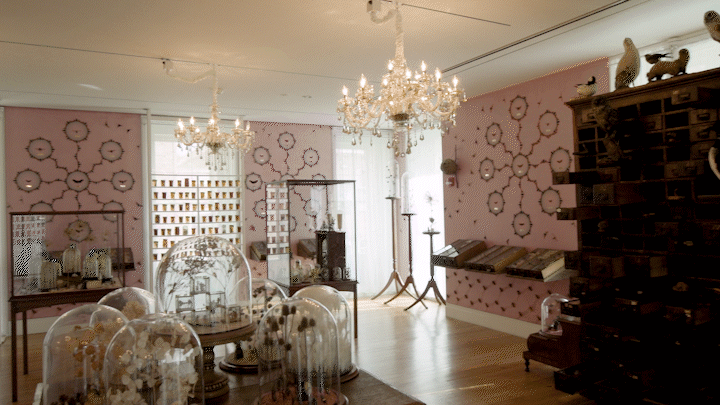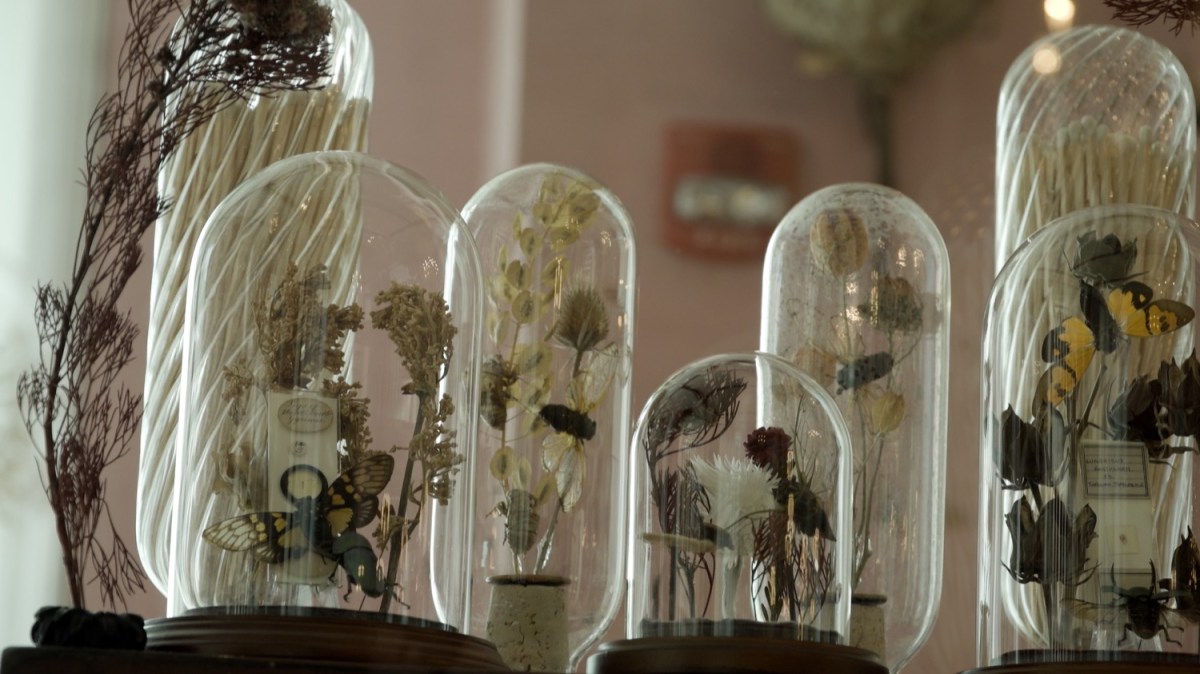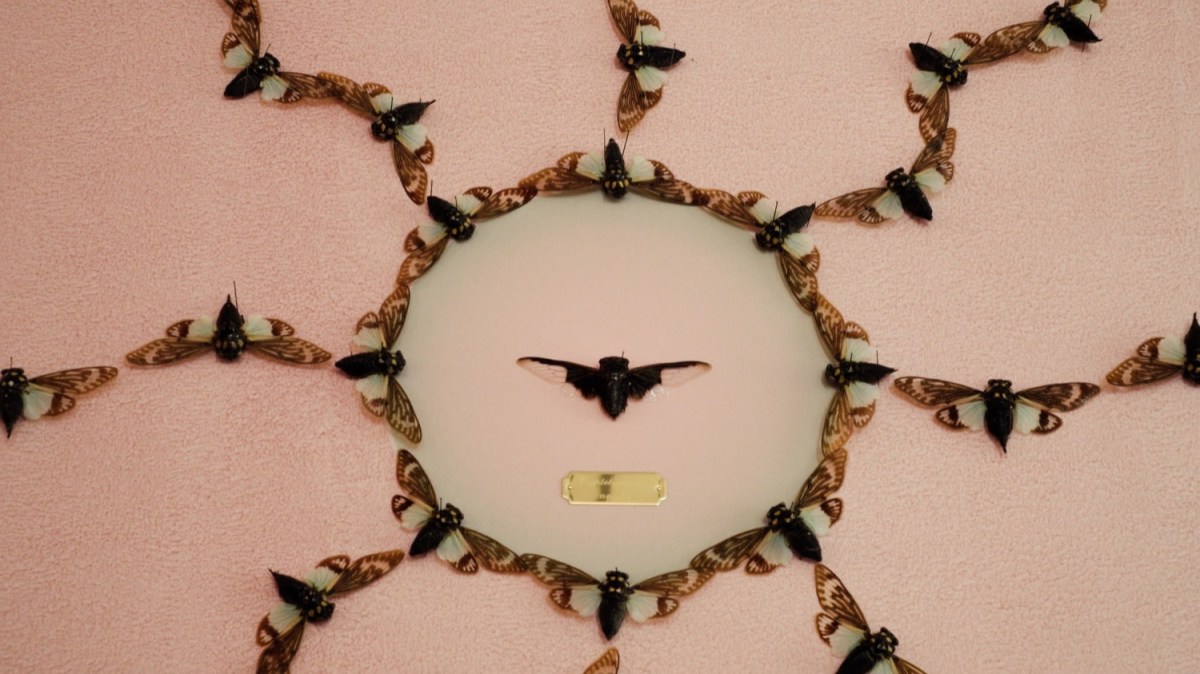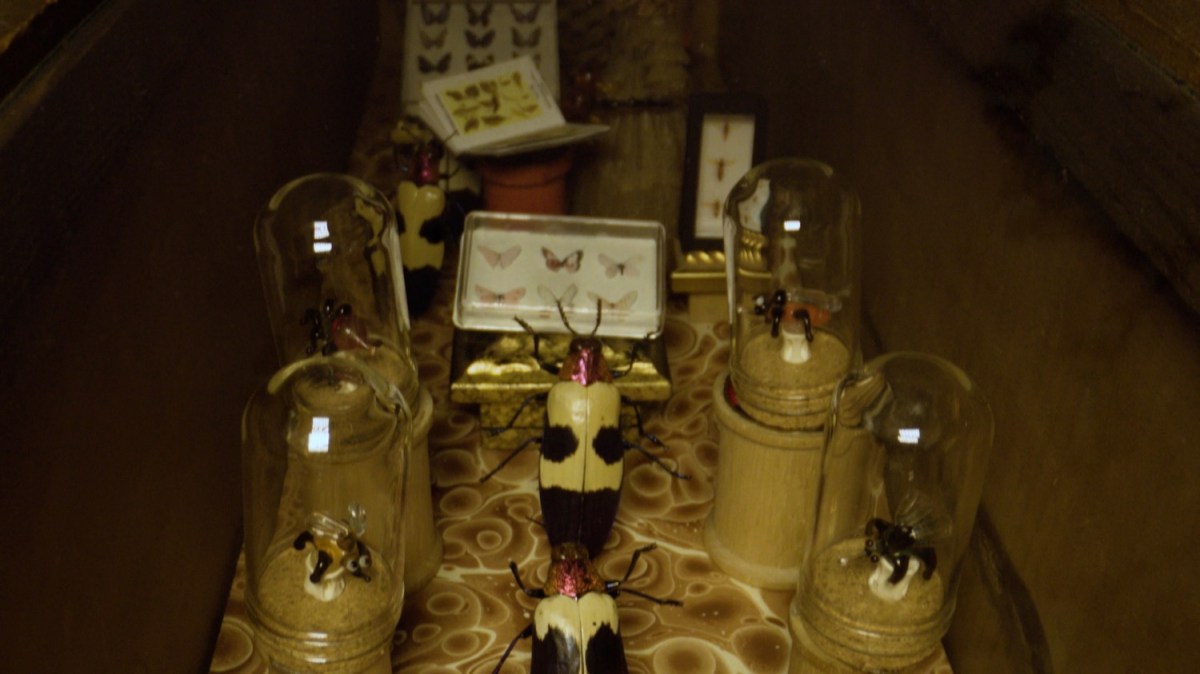The Brief And Wondrous Lives Of Cicadas
17:13 minutes
The Staten Island Museum in New York has been home to the eye-catching room full of insect art since 2021’s emergence of the Brood X cicadas. In bell jars and cabinet drawers and under glass display cases, colorful cicadas from species around the world participate in scenes of human-like activities—they read miniature books, arrange dried flowers, create textile art, converse with animal skulls, lounge on and in jelly jars, and more. It’s all part of artist Jennifer Angus’ exhibition Magicicada, an homage to our reliance on the insect world.

Producer Christie Taylor talks to Angus and Staten Island Museum entomologist Colleen Evans about the wonder of insects. Plus, how art and science can complement each other and teach even the most bug-shy visitor to appreciate the natural world.
Looking to add a little Magicicada to your life? Instructor Brittney Hahn joins John to explain her love of insect pinning and a few tips for would-be beginners. Join us for a live online class in April to learn the ins and outs of starting your own insect collection and watch the pros as they pin beetles, moths, and other insects! RSVP for this insect-pinning event here.



Invest in quality science journalism by making a donation to Science Friday.
Jennifer Angus is a professor of Design Studies at the University of Wisconsin-Madison in Madison, Wisconsin.
Colleen Evans is Director of Natural Science Interpretation and Collections at the Staten Island Museum in Staten Island, New York.
JOHN DANKOSKY: This is Science Friday. I’m John Dankosky. We’ve been talking about bats, brains, and well, now how do you feel about talking about bugs? That’s the theme of an art exhibition that’s been at the Staten Island Museum since last year’s fantastic emergence of Brood X cicadas.
It’s called Magicicada by Wisconsin artist, Jennifer Angus. And yes, that means lots and lots of insects on the walls and in displays. The exhibition is closing later this spring. But video producer, Luke Groskin, captured it in a video that you can see on our website, sciencefriday.com/insectart. And producer, Christie Taylor, also went along to see Magicicada. Hey, Christie.
CHRISTIE TAYLOR: Hey, John.
JOHN DANKOSKY: Well, I’ve seen a lot of gorgeous pictures of this. And I watched the video. But I couldn’t go myself. So maybe you can tell us what it’s like in this big room full of bugs.
CHRISTIE TAYLOR: Yeah, John. It was actually one of the best experiences I have had all pandemic so far. You walk into a big room with pink walls, which are actually made of insects, the color in them. It’s full of chandeliers, and this very Victorian array of display cases, bell jars, a giant cabinet of curiosities with dozens of drawers. And every single one of these cases and jars is a scene with pinned cicadas, other insects, household objects, buttons, flowers, fabric, all kinds of colors and textures.
If you’ve ever read an I Spy book, John, it’s kind of like a fully immersive I Spy. Cicadas are lighting matches, reading little books. They’re having deep conversations with butterflies and animal skulls. There’s something new to notice every time you look.
JOHN DANKOSKY: That sounds really amazing.
CHRISTIE TAYLOR: It really is. I would really love to go back before it closes. And I had a conversation with the artist, Jennifer Angus. She’s also a professor of design studies at the University of Wisconsin in Madison. We also talked with Colleen Evans, who is an entomologist and director of natural science interpretation and collections at the Staten Island Museum. And I started by asking Jennifer to talk about the walls of this pink Victorian room.
JENNIFER ANGUS: One will be struck by the pattern on the walls, which look kind of like a cell nucleus. Within each circle, which is formed out of cicadas, there is one unique cicada. And there are close to 50 varieties of cicadas. And under the cicada that is in the center of the circle is a brass plaque with its Latin name. So there is this tip of the hat in an art installation to the science behind this. And all of these cases are filled with insects, as are the drawers. So you are walking into a world that’s dominated by the six-legged.
CHRISTIE TAYLOR: Colleen, what would you add?
COLLEEN EVANS: There’s just so much diversity in cicadas, first of all. So a lot of the ones that Jennifer used in her work are from Southeast Asia, so they’re not ones that are native to the United States. In the United States, we’re used to seeing either the periodicals, which are these little black cicadas with those vibrant red eyes, or we see a lot of the dog day cicadas, which are kind of camouflaged looking. There are browns and greens.
But the ones in the exhibit, they’re so vibrant. So there’s oranges and blues, these colors that were not used to seeing on a cicada, but totally exist. Like Jennifer has not recolored them in any way. That’s their natural coloring. They are just that vibrant. And they create just this really fantastical pattern on the walls. And then there’s these beautiful swooshes also of cicadas kind of in between the different bacterial or viral shapes.
JENNIFER ANGUS: There’s a swarm. It’s hard to tell perhaps, if the building is swooshing or crawling, and these cicadas have decided to neatly form themselves into this pattern, or are they actually escaping these patterns?
CHRISTIE TAYLOR: Let’s contemplate that. In the meantime, Colleen, so the Staten Island Museum has a very unique relationship with the humble, and hopefully, not too creepy cicada. And it has the second largest collection in the world. How did that come to pass?
COLLEEN EVANS: So the Staten Island Museum, we were founded in the late 1800’s by a group of men, all Staten Islanders, one of whom is William T. Davis. He was 19-years-old at the time of our founding, which I just love to point out, because a lot of them were quite young. And William T. Davis in particular later in his life became the world expert in cicadas. So like the early 20th century, he was the guy you would talk to in the entire world if you had questions about cicadas whether or not what species you’re looking at, what they’re doing, what their biology is. Like, he was a guy you’d want to talk to.
And because of that– so he did a lot of collecting on his own. He was actually very particularly interested in periodical cicadas. We’ve quite a lot of those. But then people also sent him cicadas from all over the world. So we have a worldwide collection in our institution. We have probably 36,000 cicadas in our collection, which is a lot, mostly from the United States, but from elsewhere as well, so from all over the world.
CHRISTIE TAYLOR: Wow. And why was William T. Davis so obsessed with cicadas?
COLLEEN EVANS: So he first I think, got interested in the periodical cicadas. Those are the ones that emerge every 13 or 17 years on the East Coast of the United States. And they have those really large populations that emerge, literally thousands, millions, all clustered in one area. And so they create these huge sounds.
I think a lot of people who have been on the East Coast of the United States have potentially experienced it where it’s just there’s just so many cicadas in one spot. And he loved it. The name of the exhibition comes from the genus for periodical cicadas, which is Magicicada. And that’s a term that William T. Davis coined in 1925. So he realized that periodical cicadas were different enough from other cicadas that they warranted their own genus.
And he created this adorable portmanteau of the words magic and cicada, and decided that’s what they needed to be called. Because he just found them so magical.
CHRISTIE TAYLOR: That’s really interesting. Well, and Jennifer, last year was the big emergence of the Brood X, that incredible big group of 17-year cicadas, which were part of the Inspiration4 this exhibit. What was the appeal of this emergence for you and creating a piece of artwork?
JENNIFER ANGUS: So it was very clear to me that we would celebrate the cicada. I mean, there was no other way to go. And I actually with Colleen, and a friend of ours, Chef Joseph Yoon, we went to the Princeton area, which was a hot-spot of the emergence. And it was my first experience with the periodical cicadas. And I really feel that it was one of the things I will remember all my life. The day I arrived it was quite warm. And the next day, it was cold. And it was as if the cicadas had been stunned.
Now, Joseph was collecting cicadas too that he would later cook up. And Colleen and I had made a kind of agreement that what we were collecting were those that were recently deceased. I mean, we are very much– we want to see these cicadas thrive. I really got personally involved with them. Because as I was crouching down to pick up something that I thought was dead, I’d see a leg move. And I realized, oh, it’s just stunned with the cold.
And so I started picking these cicadas up, and started to feel like a bit of a matchmaker. Because that’s in cicadas, we know they’ve lived underground for 17 years. But in their adult form, they are looking for love. And so I started putting them on branches. And I yelled to Joseph, do not come over here. I’ve spent a lot of time matchmaking. I want romance to happen.
CHRISTIE TAYLOR: Jennifer, you have positioned so many of these cicadas in a really, really human position. They’re up on their rear legs. Sometimes, they appear to be teaching, or doing textile art. What was your goal in giving this sort of anthropomorphic feel to these insects?
JENNIFER ANGUS: Well, I think that one of my goals is to have people think about insects differently. We all know the importance of bees, and we’re hearing about colony collapse, the death of millions of bees. And this is already having an impact on prices of fruits. We need insects to decompose matter.
But they are also an important link in the food chain. Perhaps, that’s their greatest job. So I alluded to this emergence of Brood X in the millions. And many of those that come out of the ground first get eaten by birds and small mammals. And I think people don’t honestly don’t care a lot about insects, but they care a lot about birds. So if you’re seeing fewer birds, is it because there are fewer insects?
So I want people to start thinking about insects differently. And I anthropomorphize them, because they become a bit more relatable. If a person can think about them as leading lives perhaps parallel to our own, then there’s a sympathy, and perhaps, you won’t stomp on it, or pull out the can of RAID.
CHRISTIE TAYLOR: Colleen, is there a role for art like Jennifer’s in science communication to that same end? I mean, is beauty itself educational as you sort of see it playing out in the museum?
COLLEEN EVANS: Absolutely. So a lot of people knowing that that room is full of insects, you can almost kind of see them bracing themselves before they go in, because they’re so uncomfortable with the idea of being surrounded by insects that they really have to almost psych themselves up to walk in. Not everybody. But of course, like those people who already have maybe a phobia associated with insects, they really have to kind of take a beat before they walk in.
And you can see just while they’re moving through the exhibit, their body language changes. They relax. They calm down. They realize, oh, this isn’t actually anything to be scared of or upset by. And then you can notice that they start getting closer to the walls. They actually start seeing them as individual insects, and start asking questions.
And then like in that moment, suddenly, they’re interested, and they’re invested, and they want to know well, OK, well why? Why are these insects here? Why is it important? Why is this one different than this one? They get that moment to finally make a connection with an insect that they may not be able to do it’s a living one that’s like flying at them. That would be much more upsetting than having these arranged in a beautiful pattern where they can kind of get up close and take a minute with them.
JENNIFER ANGUS: That reminds me that people often say to me, I’d hate to see that flying at me. And some of these cicadas and other insects are so large that actually, they’re not very good flyers. So I don’t think it would be very threatening. You’d have a chance to duck. And quite honestly, they don’t fly a whole lot anyway.
CHRISTIE TAYLOR: Well, and Colleen, Jennifer, we’re entering spring finally. We might not be able to find cicadas anytime soon. But what’s going on in the insect world that we can observe that you hope we do go out and appreciate?
COLLEEN EVANS: So some insects are starting to wake up from their winter hibernations. Especially on a warmer day right now, you might start seeing, especially like some of our overwintering butterflies are starting to come out. You might seem like a morning cloak or something if you’re very lucky. And so it’s a good time to start connecting with those.
A lot of your aquatic insects are coming back to life, or at least starting to move around. So if you look in the water, you might start seeing them on a sunny day, start seeing little guys moving around in the bottom maybe coming up for air. And of course, as we move further into spring and summer, you’re going to start seeing a lot of your pollinators waking up coming to all the different flowers that are blooming. And so yeah, it’s a good time to just start connecting with them as they move around their space and start doing their thing.
JENNIFER ANGUS: You know, and so I think about insects where I live, July is a wonderful time, because the fireflies come out. And to me, those are so magical. And back to the exhibition, I think that that’s really that magic is something that I want to tap into, that really, insects are absolutely not only beautiful, but amazing. I mean, especially these periodical cicadas. Imagine 17 years underground, and then this emergence as Colleen described with William T Davis, that he named the magicicada. And I hope that is captured in the exhibition.
CHRISTIE TAYLOR: Thank you both so much for the time today.
JENNIFER ANGUS: Thank you.
COLLEEN EVANS: Yeah, thank you so much,
CHRISTIE TAYLOR: Jennifer Angus is a Professor of Design Studies and artist at the University of Wisconsin Madison. Colleen Evans is Director of Natural Sciences Interpretation and Collections at the Staten Island Museum. I’m Christie Taylor.
JOHN DANKOSKY: Thanks, Christie. And if you want to learn more about the Magicicada exhibit at the Staten Island Museum, and see what we’re talking about, we’ve got that gorgeous video walkthrough for you from video producer Luke Groskin. Check it out on our website, sciencefriday.com/insectart. The exhibit closes on May 22. Hope you get a chance to see it.
Copyright © 2022 Science Friday Initiative. All rights reserved. Science Friday transcripts are produced on a tight deadline by 3Play Media. Fidelity to the original aired/published audio or video file might vary, and text might be updated or amended in the future. For the authoritative record of Science Friday’s programming, please visit the original aired/published recording. For terms of use and more information, visit our policies pages at http://www.sciencefriday.com/about/policies/
Christie Taylor was a producer for Science Friday. Her days involved diligent research, too many phone calls for an introvert, and asking scientists if they have any audio of that narwhal heartbeat.
John Dankosky works with the radio team to create our weekly show, and is helping to build our State of Science Reporting Network. He’s also been a long-time guest host on Science Friday. He and his wife have three cats, thousands of bees, and a yoga studio in the sleepy Northwest hills of Connecticut.